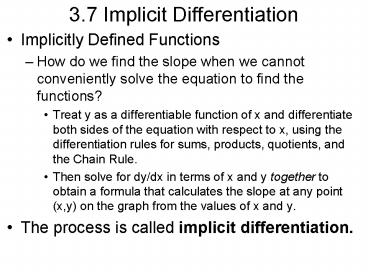3.7 Implicit Differentiation - PowerPoint PPT Presentation
1 / 14
Title:
3.7 Implicit Differentiation
Description:
3.7 Implicit Differentiation Implicitly Defined Functions How do we find the slope when we cannot conveniently solve the equation to find the functions? – PowerPoint PPT presentation
Number of Views:163
Avg rating:3.0/5.0
Title: 3.7 Implicit Differentiation
1
3.7 Implicit Differentiation
- Implicitly Defined Functions
- How do we find the slope when we cannot
conveniently solve the equation to find the
functions? - Treat y as a differentiable function of x and
differentiate both sides of the equation with
respect to x, using the differentiation rules for
sums, products, quotients, and the Chain Rule. - Then solve for dy/dx in terms of x and y together
to obtain a formula that calculates the slope at
any point (x,y) on the graph from the values of x
and y. - The process is called implicit differentiation.
2
Differentiating Implicitly
- Find dy/dx if y² x.
- To find dy/dx, we simply differentiate both sides
of the equation and apply the Chain Rule.
3
Finding Slope on a Circle
- Find the slope of the circle x² y² 25 at the
point (3 , -4).
4
Solving for dy/dx
- Show that the slope dy/dx is defined at every
point on the graph 2y x² sin y.
The formula for dy/dx is defined at every point
(x , y), except for those points at which cos y
2. Since cos y cannot be greater than 1, this
never happens.
5
(No Transcript)
6
Lenses, Tangents, and Normal Lines
- In the law that describes how light changes
direction as it enters a lens, the important
angles are the angles the light makes with the
line perpendicular to the surface of the lens at
the point of entry.
7
Lenses, Tangents, and Normal Lines
- This line is called the normal to the surface at
the point of entry. - In a profile view of a lens like the one in
Figure 3.50, the normal is a line perpendicular
to the tangent to the profile curve at the point
of entry. - Profiles of lenses are often described by
quadratic curves. When they are, we can use
implicit differentiation to find the tangents and
normals.
8
Tangent and Normal to an Ellipse
- Find the tangent and normal to the ellipse x2
xy y2 7 at the point (-1 , 2). - First, use implicit differentiation to find dy/dx
9
Tangent and Normal to an Ellipse
- We then evaluate the derivative at x -1 and y
2 to obtain - The tangent to the curve at (-1 , 2) is
- The normal to the curve at (-1 , 2) is
10
Finding a Second Derivative Implicitly
- Find d²y/dx² if 2x³ - 3y² 8.
- To start, we differentiate both sides of the
equation with respect to x in order to find y
dy/dx.
11
Finding a Second Derivative Implicitly
- We now apply the Quotient Rule to find y.
- Finally, we substitute y x²/y to express y in
terms of x and y.
12
Rational Powers of Differentiable Functions
13
Using the Rational Power Rule
- (a)
- (b)
- (c)
14
More Practice!!!!!
- Homework Textbook p. 162 2 42 even.































